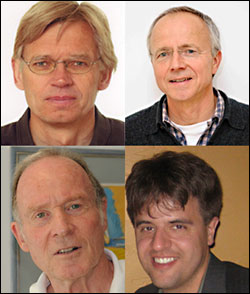
Optogenetics Pioneers Win Zülch
Four scientists who initiated and were instrumental in promoting optogenetics will be recognized tomorrow with the K.J. Zülch Prize 2012 from the Gertrud Reemtsma Foundation.
In announcing the prize recipients — Ernst Bamberg of Max Planck Institute of Biophysics in Frankfurt, Karl Deisseroth of Stanford University in California, Peter Hegemann of Humboldt University Berlin and Georg Nagel of the University of Würzburg — the foundation acknowledged the great importance of the still-young research field, which has caused a revolution in the neurosciences.

Optogenetics pioneers Peter Hegemann of Humboldt University Berlin (top left), Georg Nagel of the University of Würzburg (top right), Ernst Bamberg of Max Planck Institute of Biophysics (bottom left) in Frankfurt, all in Germany, and Karl Deisseroth of Stanford University in California (bottom right) have won the K.J. Zülch Prize 2012 for their work. (Photo: MPG)
Optogenetic methods open up completely new investigative possibilities — from basic neuroscientific research to biomedical applications — and have been useful in investigating neurological diseases such as epilepsy, Parkinson’s, depression and age-related blindness. Using these techniques, researchers can provide nerve cells with light-sensitive protein channels and ion pumps and, thus, specifically control them with light. This has led to a large number of studies worldwide within a very short time.
The single-cell freshwater alga Chlamydomonas reinhardtii and the salt lake archaebacterium Natronomonas pharaonis have light-sensing proteins called rhodopsins for orientation and energy production. Hegemann began to study the light perception of algae back in 1985 when he was working at Max Planck Institute of Biochemistry in Martinsried. From 1995 on, Nagel and Bamberg at Max Planck Institute of Biophysics transferred various bacterial rhodopsins to frog spawn and human kidney cells, describing their electrophysiological properties.
Between 2002 and 2003, Hegemann (then at the University of Regensburg), Nagel and Bamberg demonstrated a remarkable property of algal rhodopsins: By transferring the rhodopsin gene to egg cells of the clawed frog, they found that the algal rhodopsins unify the light receptor and ion channel in a single protein. When blue light is incident, the protein channel becomes permeable for protons and positive potassium and sodium ions. The cell potential is therefore shifted toward the positive. The algal rhodopsins, which the researchers called channelrhodopsins, therefore differ from many other light-sensitive proteins, such as rhodopsins in the human eye, which do not have their own directly light-activated ion channel.
Based on these results, groups throughout the world began to use the channelrhodopsins as tools to investigate cells. Researchers, including the three pioneers, thus activated channelrhodopsins in the nerve cells of the nematode Caenorhabditis elegans and in hen embryos and mice. With channelrhodopsin-2 and halorhodopsin, they could control the mobility of the nematode, for example, because halorhodopsin “pumps” negatively charged chloride ions into the nerve cell after activation with yellow light, shifting the cell potential further toward the negative and inhibiting the cell. This allowed the nerve cells of the worm to be activated with blue light and deactivated with yellow light.
Deisseroth also recognized at an early stage the enormous potential of channelrhodopsins for the neurosciences because the activity of nerve cells is based on the influx of sodium ions; i.e., precisely those ions that also flow through channelrhodopsin. In 2005, working with Nagel and Bamberg, he transferred channelrhodopsin-2 into nerve cells of the brains of rats, using optogenetics to trigger action potentials for the first time. He also succeeded in activating channelrhodopsins in the brains of free-moving rats by conducting light through glass-fiber cables directly into their brain. This enabled him to study a variety of animal species to see how nerve cells generate behavioral patterns such as movement, fear or social behavior, and how learning and memory processes occur.
The four prizewinners are still working to improve the channelrhodopsins for optogenetics, which requires biophysical and biochemical investigations for more detailed understanding of the channels' molecular mechanisms. The scientists have already described variants that manage with less light, that react more rapidly and that are sensitive to variouslight wavelengths.
For more information, visit: www.mpg.de/6335155/zuelch_prize_2012-optogenetics
Published: September 2012